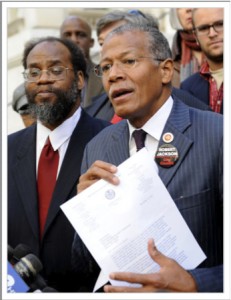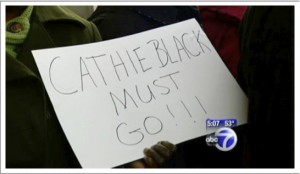The Cathie Black Fiasco: Lessons for Confronting Entrenched Power
Nearly 3 years have passed since that quiet afternoon in November 2010 when I glanced at my phone to see the newsflash:
SCHOOLS CHANCELLOR JOEL KLEIN STEPPING DOWN. BLOOMBERG TO APPOINT CATHLEEN P. BLACK, HEARST MAGAZINE, AS REPLACEMENT
The news is always presented so matter-of-factly, so unemotionally. The effect is predictable and comforting to so many in a hectic, unpredictable world like the one we inhabit. The news usually makes sense of it for us.
Usually, but this news didn’t make sense. Not to me.
I called my teacher friends, then a principal, then a parent advocate. Nothing but confusion. Nothing but disbelief. And shoulder-shrugging acquiescence. There’s enough crisis fatigue going around the public school system to slide this next unbelievable fact into the shoebox of unbelievable, but inevitable, administrative moves. Mayoral control means mayoral control, and if you don’t like it “you can boo me at parades.”
Hold on a minute.
There’s laws protecting us from this? Protecting the public from administrative overreach and cronyism, right? You need some educational experience – maybe a year in the classroom – to run the largest school system in the country, right?
Not quite. You do need permission from the state, in the form of a waiver signed by the State Commissioner of Education, which I found out as I frantically researched the laws online. At the time, his name was David M. Steiner, something of an academic himself. He was close with the Mayor, the Upper East Side political elite, and the charter school operators – what I call the new ‘corporate education reform’ establishment – but perhaps he could be swayed?
So I sat down and wrote an open letter to David, asking him not to grant the waiver to Cathie Black. I posted it up onto an online petition site and sent it around to a few friends in the schools. I couldn’t have imagined what would happen next.
Building Momentum
That night, my email and petition ricocheted across the internet. I realized quickly that so many people felt as I did that there was something fundamentally wrong about this move by the Mayor, and that we had to stop it. I also knew that an online petition alone wouldn’t do it, so I sent a Facebook message to some of my former students in Red Hook:
Want to help get rid of Cathie Black? Msg me back.

The next day, four of us met in Red Hook at a cafe near the school I used to teach in. Red Hook is a quiet but potent hotbed of resistance against mayoral control and the encroachment of centralized power into education, and we quickly set to work on a ground campaign to flyer and canvass the neighborhood for petition-signers. Our group grew, and we got a dose of reality when my former principal came into the cafe one day and nervously warned me against organizing anything in the neighborhood. (By this time, newspaper accounts of our work had begun to circulate, some mentioning the school and alluding to the political battle that ultimately led to my departure from the school and resignation from the DOE. Lesson #1: It’s often easier to confront power from outside the system.)
As our efforts grew, and the neighborhood became activated to our cause, we set up shop in the office of a friend of mine. She was also nervous about any public association with our group, so we kept our presence there “under wraps”.

By this time, political momentum against the appointment had begun to build. Lead by the grassroots success of our petitioning, one by one local electeds andcommunity leaders began to speak out against the Mayor, though often in deeply-softened terms. It became apparent that the City was on the offensive as well now, rallying elite celebrities like Oprah and business leaders to “endorse” Cathie Black. Remarkably, as noted by education historian Diane Ravitch, the City didn’t think to gather the support of any education experts, but Cathie did reach out personally to UFT President Mulgrew, perhaps encouraged by his offer to help train her and his endearing words about her in a NY Times piece days before. (Later, Mulgrew would take on a much more adversarial tone as public opposition to her appointment intensified.)
When the People Lead the Leaders Will Follow
In the last week of November, opposition intensified and got more creative (e.g. this group of teachers who go to apply for Cathie Black’s job at Hearst). The NY Times came out with a piece about the internal dilemma Commissioner Steiner was having over whether to approve Cathie. He assembled a panel of “experts” to help guide him through the decision – experts that many of us were certain would side with the Mayor – but this panel had actually voted against her appointment. He now had to figure out how to do this appointment right. Meanwhile, we printed out the thousands of public comments on our petition and delivered it right to the Commissioner’s door.
‘Cathie Black Gets Her Stinking Waiver’
On Monday morning, we awoke to the news – this headline’s from Gawker – that the Commissioner had sided with the Mayor, albeit with a caveat: in order for Cathie to get the job the Mayor must appoint a “second-in-command”, a chief academic officer to assist Cathie in all things educational. As one anonymous State Education Dept. official put it:
“This is the product of an extensive dialogue between the state and the city about the concerns raised by the commissioner. The feeling is that it substantially addresses those concerns”
It was a slap in the face to the tens of thousands – perhaps millions – of New Yorkers who had rallied, petitioned, signed, called, emailed, commented and – yes – complained about the Mayor’s bonehead move.
Here’s where things get interesting…
Legal Action & Disruption
The Deny Waiver Coalition – of which I was a part – immediately decided to file a lawsuit against the appointment. At meetings and on conference calls, I reminded the (mainly-adult) members of this group that there must still be a way for regular folks to voice their opposition. We needed sustained action, and the Panel For Educational Policy (PEP) meetings became that exact forum.
For three long months, we made it nearly impossible for Cathie Black to speak. It’s important to note that this was not a noble, pretty protest. This was

organized chaos: yelling, booing, jeering, singing, picketing, protesting. The idea was simple: you are not qualified to lead our schools, let alone shut down 22 of them!
The protest became a wider referendum on Mayoral Control, which ultimately had led to this fiasco, yet the first demand remained clear: FIRE CATHIE BLACK.
Finally, on February 3rd, Cathie Black lost her cool. She fired back at our boos with a jeering sound that showed utter contempt for our protest and our legitimate grievances against her boss, Mayor Bloomberg. The Daily News called that night an “ugly circus”, blaming the teachers unions. But the damage had already been done.
We had kept up the sustained pressure and scrutiny that turned every word, every action, but Cathie Black into a headline. She was quoted at a parent meeting talking about birth control as a solution to lower Manhattan school over-crowding. Camera crews followed her around and she couldn’t get into the schools.
This is what resistance looks like.
Finally, with a 17% approval rating and a populace in plain revolt, Cathie Black stepped down, or was fired, after merely 100 days in office.
Uncovering the Emails
America journalist and humorist Finley Peter Dunne said that “the job of the newspaper is to comfort the afflicted and afflict the comfortable.” One independent reporter, Sergio Hernandez then at the Village Voice, took the motto seriously: he sought to uncover the email exchanges between Cathie Black and City Hall in the early days of her appointment. Why had she been appointed? How was the city handling her appointment?

Sergio realized that inter-agency emails are generally protected from Freedom of Information requests, but Cathie Black was not a City employee at the time of her appointment and her communications with the City were not protected from public view. For two years, he battled with the City in court to release the emails. When they further-entrenched themselves, he lurched forward to uncover the costs of their legal defense: more than 168 hours and $25,461.42 in litigation time.
This week, we saw what the Mayor had spent over $25,000 of taxpayer money defending: the City’s frantic efforts to justify his appointment of Cathie by means of celebrity endorsements and well-placed news quotes, phone calls to union leaders and local politicians. The emails reveal a coziness between City Hall and big money that confirms what I have long suspected: Michael Bloomberg is completely detached from the day-to-day realities of the 99%. (He frets constantly about losing the top .05% of taxpayers, though!) The emails also reveal a very calculated attempt on the part of City Hall to manage and control the flow of information to the general population through media outlets like the NY Times. A year later, when Occupy Wall Street hit, we’d learn just how tight that relationship was when a call from City Hall led to TIME magazine removing an “overly-inflammatory” photo of an elected official being arrested during the Zuccotti Park eviction.
Brave journalists like Sergio Hernandez are the life-blood of corporate and governmental transparency and accountability efforts, and they should be honored.
The Next Cathie Black Moment
It is impossible to not place this whole fiasco on a continuum of escalation of public discontent with our unaccountable, unrepresentative “leaders”. Not long after Cathie resigned did sleeping bags pop up outside of City Hall for Bloombergville, a protest against budget cuts to education, healthcare and more in Spring, 2011. When City Councilman Charles Barron of Brooklyn’s East New York neighborhood stood on the steps of City Hall that month and declared that we would “Bring Egypt to NYC” and “shut this city down!” he wasn’t far off: weeks later 20,000 New Yorkers marched on Wall Street. Then, on September 17th, 2011, 150 brave citizens – including myself – occupied Wall Street with tents. The resistance continues.
In Cathie Black we saw the epitomy of cronyism and the removal of any real agency from the decisions that affect our lives, but Cathie Black moments abound

in NYC today. Slowly, the democratic structures that give us voice and power have been stripped away from us, privatized, barricaded behind ever-growing bureaucracy and harsh police enforcement. The social contract is broken each day. The rising inequality and burdening debt that puts half of New Yorkers in, or at the brink of, poverty also steals from us the precious few hours of freedom from work that we need to be active contributors in our civil government. As the old saying goes: something’s gotta give.
There will be more Cathie Blacks, but we can take lessons from this struggle as one of the few true victories against corporate control of our lives. As the number of our grievances accumulate exponentially, let us not forget that there’s at least one Cathie Black behind each of them. Let us not forget that it was only through sustained pressure on many fronts – legal, journalistic, direct action, political – that the effort to un-seat Cathie Black came to fruition. At each step along the way, resistance was present, and every action that drew us nearer to victory was branded as a “failure” or a “circus” or a petty “disruption” by those in power opposed to change.
Shortly after Cathie Black resigned, the David I wrote my open letter to followed suit and stepped down. When the Daily News asked Cathie how she was feeling she replied:
“I’m fine, I’m fine… And I went out and bought a new pair of running shoes, so I’m off.”
Justin Wedes is an educator & activist living in Brooklyn, NY. He is co-founder of the Paul Robeson Freedom School, a youth summer program sponsored by the Coalition for Public Education & Occupy Labs to train the next generation of youth & educator-leaders to create real education reform and community-controlled public schools. He’ll be hosting a Cathie Black Email Reading Party to benefit the school this Sunday, May 5th, 7-9pm, at DBA Bar in the Village.

